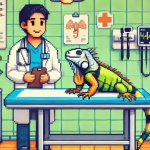
Hybrid Bird Species and Pet Health
In the ever-evolving realm of pet care, the role of hybrid species has become a subject of increasing interest and meticulous scrutiny. Birds, often revered for their beauty and companionship, present compelling case studies in both nature and urban ecosystems. This article explores recent discoveries and discussions surrounding hybrid bird species and the implications for pet health.
The Rise of Hybridization in Birds
Hybrid birds, such as the offspring documented between a green jay and a blue jay in Texas, present a fascinating example of crossbreeding facilitated by changing environments, such as those influenced by climate change These hybrids are not only natural wonders but also embodiments of ecological shifts that are reshaping species boundaries.
What It Means for Pets
Hybrids can bring unique traits and behaviors to the world of pets. For instance, hybrid vigor, or heterosis, is often cited in avian and other animal studies as a factor that could potentially yield stronger, healthier animals. However, these benefits must be weighed against potential challenges in care and management.
Health Considerations and Challenges
One concern with bird hybrids is their susceptibility to unique health challenges. These can include dietary requirements, behavioral issues, and the psychosocial needs driven by their mixed genetic makeup. Responsible breeding is crucial, as it profoundly impacts these areas.
Hybrid Birds and Their Role in Ecosystems
Beyond the confines of domestic settings, hybrids like the sulphur-crested cockatoo and galah mix in Australia showcase ecological significance, often filling niches or coping with environmental changes source. Their existence can inform conservation strategies, as they often serve as indicators of environmental health and responses to climate change.
Pet Birds and Hybrid Concerns
As pets, hybrid birds may challenge owners with their diverse needs. The discussion on breeding such hybrids is nuanced, and while certain parrot species can interbreed, it’s not universally accepted in aviculture due to concerns over genetic integrity and ethical breeding practices.
Exploring New Frontiers in Avian Care
The research and interest in hybrid birds are indicative of broader trends in pet care and animal health. The intersection of genetics, environment, and pet ownership requires ongoing research and adaptation. As these hybrids navigate both wild and domestic worlds, they underscore the importance of tailored care and conservation-friendly practices, reiterating the need for informed, sensitive handling.
Conclusion: Enriching the Pet Health Paradigm
Hybrid birds present both a challenge and an opportunity in the pet industry, requiring innovation in veterinary care and breeding ethics. As caretakers, pet owners are encouraged to remain informed and observant, ensuring these creatures continue to thrive in both homes and their natural habitats.
Further exploration and understanding of hybrid birds promise to enrich our approach to their care and conservation, opening new avenues in pet health and ecological sustainability.




